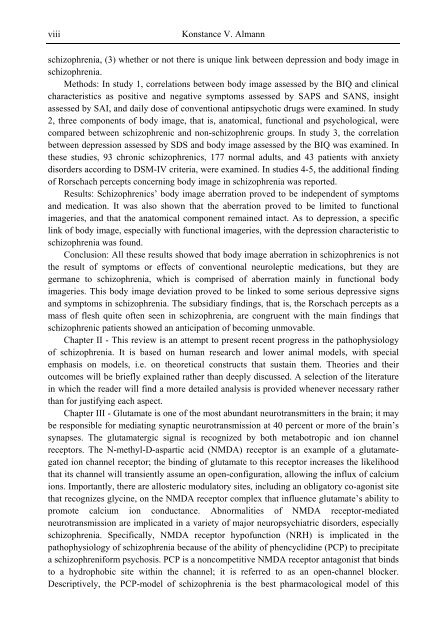Schizophrenia Research Trends
Schizophrenia Research Trends
Schizophrenia Research Trends
- No tags were found...
You also want an ePaper? Increase the reach of your titles
YUMPU automatically turns print PDFs into web optimized ePapers that Google loves.
viiiKonstance V. Almannschizophrenia, (3) whether or not there is unique link between depression and body image inschizophrenia.Methods: In study 1, correlations between body image assessed by the BIQ and clinicalcharacteristics as positive and negative symptoms assessed by SAPS and SANS, insightassessed by SAI, and daily dose of conventional antipsychotic drugs were examined. In study2, three components of body image, that is, anatomical, functional and psychological, werecompared between schizophrenic and non-schizophrenic groups. In study 3, the correlationbetween depression assessed by SDS and body image assessed by the BIQ was examined. Inthese studies, 93 chronic schizophrenics, 177 normal adults, and 43 patients with anxietydisorders according to DSM-IV criteria, were examined. In studies 4-5, the additional findingof Rorschach percepts concerning body image in schizophrenia was reported.Results: Schizophrenics’ body image aberration proved to be independent of symptomsand medication. It was also shown that the aberration proved to be limited to functionalimageries, and that the anatomical component remained intact. As to depression, a specificlink of body image, especially with functional imageries, with the depression characteristic toschizophrenia was found.Conclusion: All these results showed that body image aberration in schizophrenics is notthe result of symptoms or effects of conventional neuroleptic medications, but they aregermane to schizophrenia, which is comprised of aberration mainly in functional bodyimageries. This body image deviation proved to be linked to some serious depressive signsand symptoms in schizophrenia. The subsidiary findings, that is, the Rorschach percepts as amass of flesh quite often seen in schizophrenia, are congruent with the main findings thatschizophrenic patients showed an anticipation of becoming unmovable.Chapter II - This review is an attempt to present recent progress in the pathophysiologyof schizophrenia. It is based on human research and lower animal models, with specialemphasis on models, i.e. on theoretical constructs that sustain them. Theories and theiroutcomes will be briefly explained rather than deeply discussed. A selection of the literaturein which the reader will find a more detailed analysis is provided whenever necessary ratherthan for justifying each aspect.Chapter III - Glutamate is one of the most abundant neurotransmitters in the brain; it maybe responsible for mediating synaptic neurotransmission at 40 percent or more of the brain’ssynapses. The glutamatergic signal is recognized by both metabotropic and ion channelreceptors. The N-methyl-D-aspartic acid (NMDA) receptor is an example of a glutamategatedion channel receptor; the binding of glutamate to this receptor increases the likelihoodthat its channel will transiently assume an open-configuration, allowing the influx of calciumions. Importantly, there are allosteric modulatory sites, including an obligatory co-agonist sitethat recognizes glycine, on the NMDA receptor complex that influence glutamate’s ability topromote calcium ion conductance. Abnormalities of NMDA receptor-mediatedneurotransmission are implicated in a variety of major neuropsychiatric disorders, especiallyschizophrenia. Specifically, NMDA receptor hypofunction (NRH) is implicated in thepathophysiology of schizophrenia because of the ability of phencyclidine (PCP) to precipitatea schizophreniform psychosis. PCP is a noncompetitive NMDA receptor antagonist that bindsto a hydrophobic site within the channel; it is referred to as an open-channel blocker.Descriptively, the PCP-model of schizophrenia is the best pharmacological model of this
















